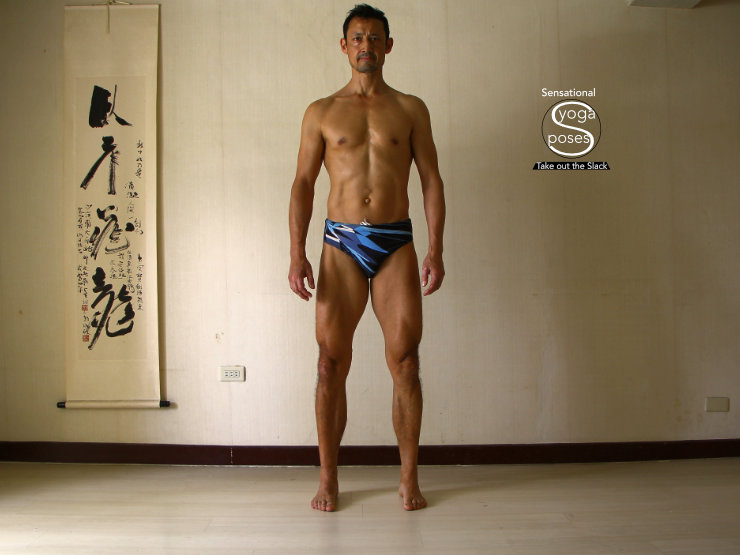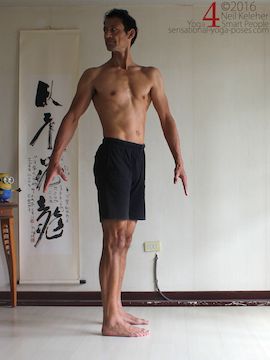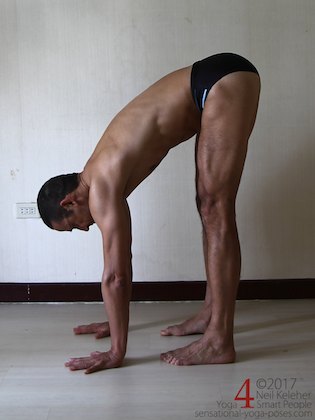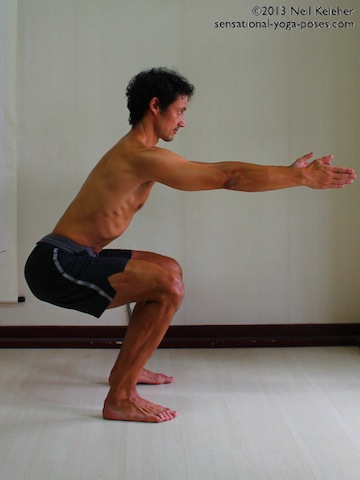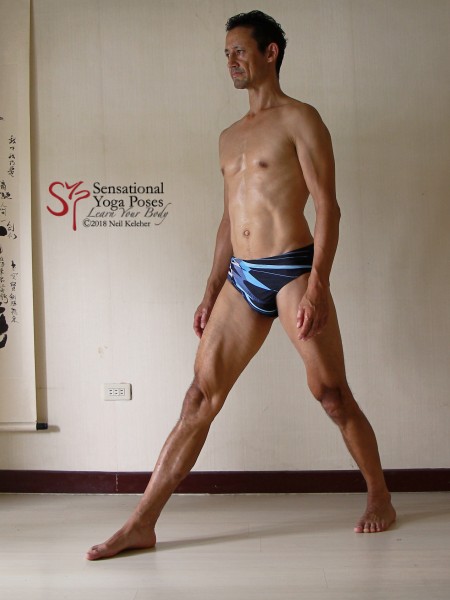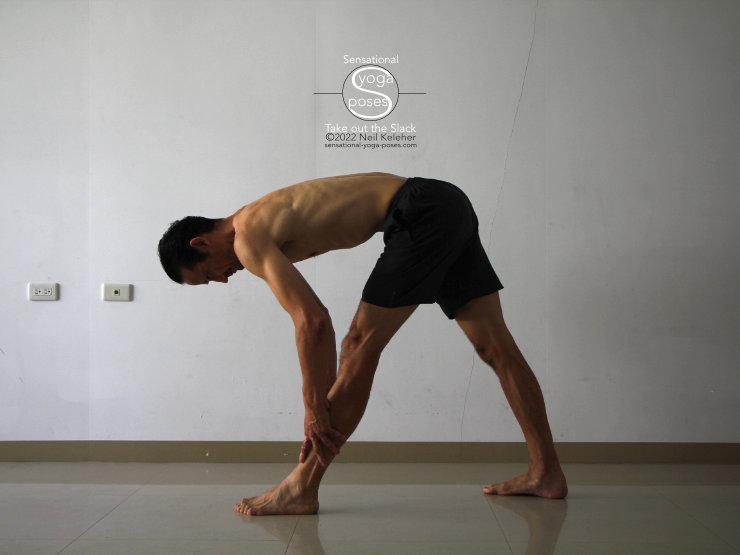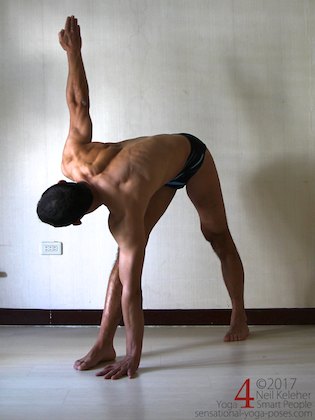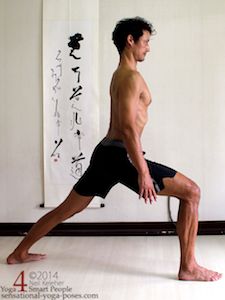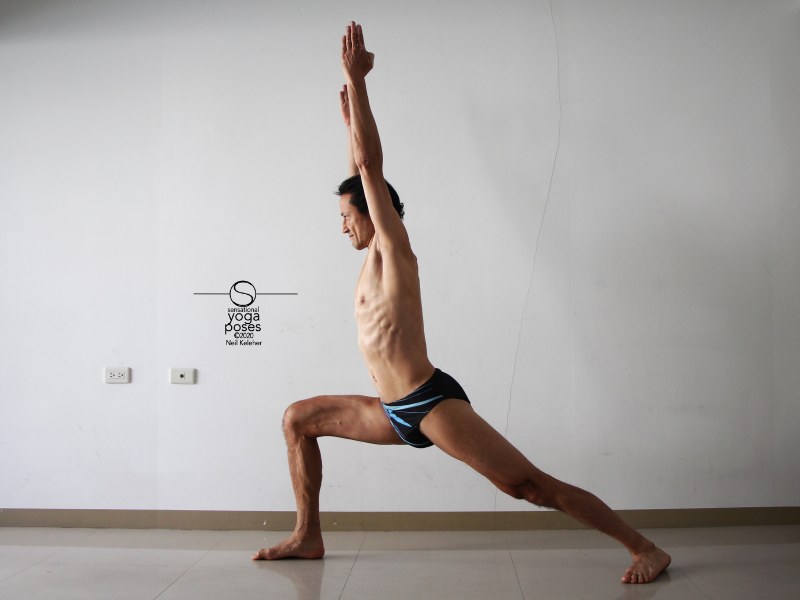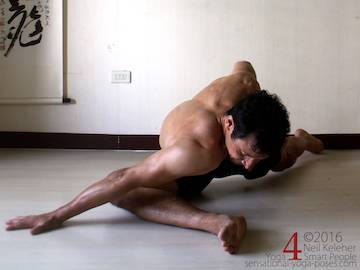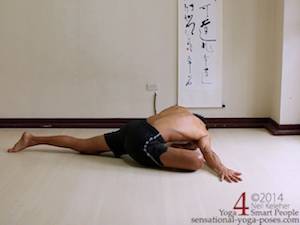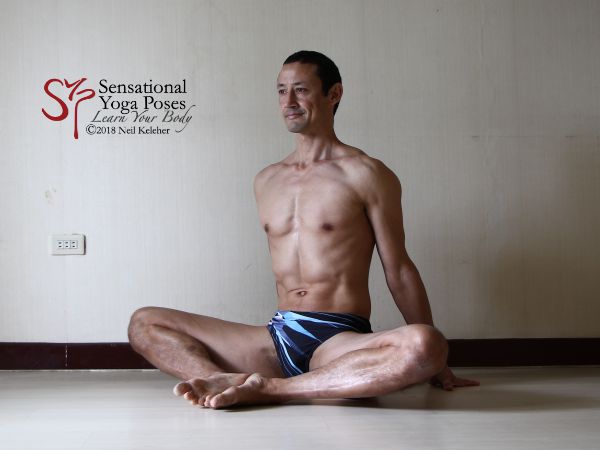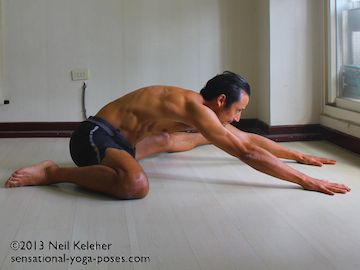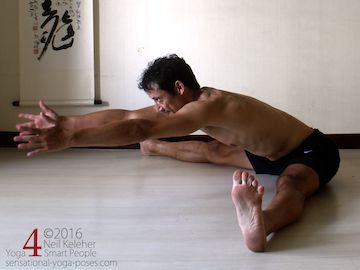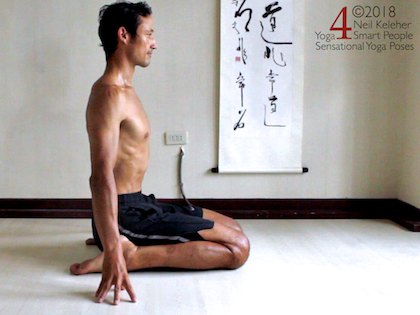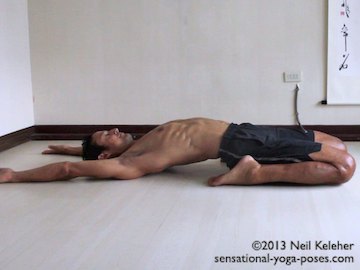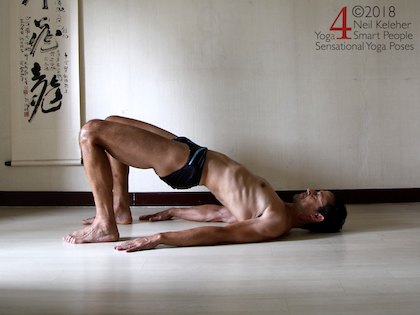Learning to feel the effects of rotation
The descriptions below start with basic hip rotations. These exercises ideally help you differentiate between internal and external rotation, so at least when you read on you'll know to which action I am referring to. In addition they give you a chance to feel the muscular actions that occur when you do either rotation. Your task then in the yoga poses that follow is to try to duplicate those actions.
In addition notice how the actions affect your yoga pose as a whole. Do the actions make the pose feel more stable or solid? Do they feel good? Do they feel "right"? Do they make the pose easier? Do they make the pose feel worse or simply different?
As you get more experience with the actions you can choose whether or not to use them. But first I'd suggest that you need enough experience to make informed judgements. That experience can include experimenting with these actions and with what you do around those actions. Is there a way to vary the tension that you feel when you do an external hip rotation?
How to learn the differences between internal rotation and external rotation
Before going on, we should clearly define internal and external rotation for the thighs.
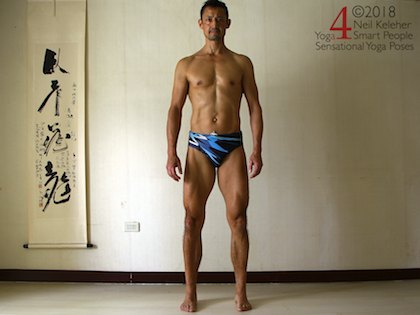
For external rotation of the legs, the inner thighs roll forwards.
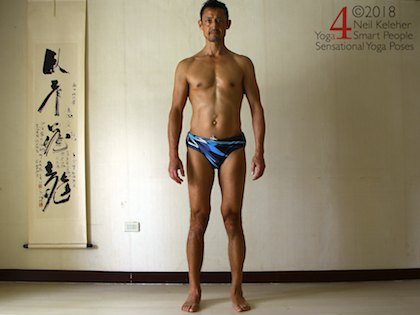
The opposite happens for internal rotation.
Standing upright twist for the hips and spine
A very simple standing shoulder and hip rotation exercise with a twist has the feet hip or shoulder width apart and parallel.
Turn the pelvis to the right so that you are twisting both hips. Then turn your ribcage to the right also so that you are twisting your thoracic spine.
With a twist of the pelvis to the right, the front of the right hip is closed. To accentuate this closing, roll the right thigh inwards. This uses the internal hip rotators of the right thigh. However you aren't just using them to roll the thigh inwards, in this pose you are also using them to help accentuate the turn of the pelvis to the left.
At the same time the front of the left hip is opened. To accentuate this opening roll the left thigh outwards. This uses the external hip rotators or the left thigh. These help to roll the thigh outwards but also help to turn the pelvis to the left.
Each time you repeat the action to the same side notice where you feel the tension in your legs and hips when you turn your pelvis and rotate your legs.
Work at doing the actions smoothly. You can repeat the actions slowly and smoothly without holding. You can also hold the end position and see if you can twist and turn deeper.
Adding more detailed actions to your rotations
Activate your feet so that your arches lift and your feet grab the floor. You can also experiment with squeezing the knees (activating the muscles that act across the front and back of the knees.)
So what then to do with the neck? Make if feel long. And turn it in the same direction as your pelvis and ribcage.
And as for your eyes, fix them on a single point outside of yourself. Use a point that helps you to deep the twist. Or focus your gaze inwards. Look inside your body.
Yoga poses you can experiment with
Some of the standing yoga poses that these rotation actions can be used in include: triangle forward fold, triangle twist and warrior 1. You can also try these actions in chair pose.
Seated yoga poses that you can use these actions in include: seated forward bend with legs crossed, bound angle or butterfly yoga pose, frog pose, half splits, low pigeon and high pigeon.
You can also use them in backbending yoga poses like bridge and wheel pose as well as in forward bending yoga poses.
You can also play with these actions in poses where the arms support the weight of the body such as in Downward dog, chaturanga dandasana, table top yoga pose and reverse plank.
What follows are some examples of what I've tried. Use them as guidelines for your own practice.
Rotating the thighs in the same direction, part 1
Standing forward bend
Sticking with the feet shoulder width apart, we can experiment with doing the leg actions while doing a standing forward bend. Rest with your hands on your thighs, or shins or on the floor. Roll both thighs to the right (right leg rolls out, left leg rolls in), relax and then try it to the left.
In a bent forwards position it can be difficult to decide which way is left and right when turning the pelvis. So instead, don't worry about it and instead focus on twisting your legs.
Then rest. We'll return to this yoga pose momentarily.
Chair pose
We can now try the same thing in chair pose.
Reach your hips back, bend your knees and reach your arms forwards. Roll the thighs to the right (right thigh rolls out left thigh rolls in.) Then return to center and then do it to the left. Then stand to rest and repeat.
What you may have noticed is that your pelvis twists as you spiral your thighs.
When doing these actions in chair pose, keep your knees the same width apart. Allow them to move but keep them the same width as your knees.
Rotating thighs externally and internally
Next while standing with legs straight, roll both thighs out, then roll both thighs in. Do both actions slowly and see how these actions affect your pelvis. For myself when I roll my thighs out my pelvis tilts rearwards so that my pubic bone moves up. When I roll my thighs inward my pelvis rolls forwards so that my pubic bone drops.
You can try alternating both actions while doing the standing forward bend and then chair pose.
Chair pose
When doing chair pose, because the knees are bent, work at keeping the knees foot width apart. Rather than letting them move in or out, keep them still. You can roll your arms out and in with the legs.
Standing forward bend
In the forward bend, since when the thighs roll in the pelvis tilts back, you can go with this action and bend your spine forwards. Then since when rolling the thighs out the pelvis tilts forwards, arch your spine backwards.
Another point to notice is the feeling at the back of the thighs. I find that when rolling the thighs inwards the back of the thighs feel like they are spreading. This may make tilting the pelvis forwards easier.
Rotating both thighs in the same direction, part 2
Now lets return to the first action where the thighs roll in the same direction (both to the right or both to the left.)
Upright pyramid pose
Standing with the right leg forwards and the left leg back, with both knees straight and the pelvis facing the front, we can practice turning the pelvis to the right while rolling the right thigh. We can roll the left thigh outwards. (The torso is still upright.)
Pyramid pose
With the arms on the front shin or the floor, do the same thing.
Now turn the pelvis to the right and the ribcage. Reach the arms back or reach the left arm across the right thigh. Here again right thigh rolls inwards while left thigh rolls outwards. Find a slow and steady rhythm and practice activating and then relaxing.
Twisting triangle
Say you want to get more of a twist out of the second yoga pose, triangle twist (the first was triangle forward bend or "pyramid pose".) With the right leg forwards we can try turning the pelvis to the left but then turn the ribcage to the right. Since we want both legs to help in turning the pelvis, we then roll the right thigh out and the left thigh (the back thigh) in. Try to keep the arches of both feet activated while doing so.
Both arms can reach back, or you can rest one hand on the floor or on the front leg. In this case, try reaching the other arm outwards, to the side, and then upwards as you deepen the twist.
Warrior 1
For warrior 1, the normal tendency is for the pelvis to turn away from the front leg. The challenge is then turning the pelvis square to the front.
To help this action we can roll the back thigh out and the front thigh in. However we don't want the front knee to collapse inwards. And so we keep the knee stable, pointing over the foot but we duplicate the feeling of internal rotation.
Now these are suggestions. And what I actually do is try out both internal and external rotation to see how each feels. You can do the same thing. It helps if you know what you are trying to do in a pose, but if you don't, experiment and see what feels good or what makes the yoga pose you are doing feel easier, more comfortable or less fragile. You could describe it as a feeling of working hard but the work feels like good work that you and your body both enjoy.
Now then, to the floor.
Internal and external thigh rotation while doing seated yoga poses
In one of my yoga classes I wanted to teach these actions for the first time to some students but I wasn't sure how to start in a seated yoga pose. So I tried it with legs crossed and arms reaching straight ahead. We practiced externally and internally rotating both the thighs and the upper arms.
For the thighs, the feeling is like the inner thighs are pressing outwards and then inwards.
Intense pigeon pose
These actions, particularly the external rotation, lend themseles to low pigeon, particularly the screaming pigeon variation.
You can focus on externally rotating the front thigh. And just for fun you could also try doing it with the back leg.
And just to notice how it feels, you can also try internal rotation of the thighs.
Bound angle pose
In bound angle pose, while sitting upright with arms behind the back I found that pressing the inner thighs forwards, internally rotating the thighs, helped get my knees down. And bending forwards this continued to be true.
That being said, I like to practice both options.
Frog pose/hurdlers stretch
In frog pose, which could also be thought of as a variation of hurdlers stretch, you can experiment with rolling the thighs, both thighs, inwards and then outwards. Or focus on pressing the inner thighs up and then down.
You can do this while bending straight forwards, towards the straight leg, or while bending forwards between both thighs as shown below.
You might also experiment with rolling both thighs in the same direction. You may find that this lessens the fragile feeling of this pose. For me I normally feel this deep in the hips, as if I' working on the connective tissue at the joint capsule. Spiralling the thighs seems to lessen the discomfort.
Wide leg seated forward bend
With legs wide in seated wide leg forward bend, you can do the same thing, roll thighs in and out.
Note, you can go for the feeling of the actions (activating your internal and external rotators). In either case you might choose to keep your knees pointing inwards. As a result you may find that your pelvis tilts forwards or backwards as you use your thigh rotators.
Hero pose/virasana
Do the same in hero pose (virasana) and even reclining hero pose (supta virasana.)
Because you are kneeling in both of these positions, you won't get much movement. However, you will get some muscle activation. Note how it feels on your knees in either case.
Additionally, for both poses, try varying the distance between your knees. Experiment with different positions and then use a knee position that feels comfortable for both knees and for both hips (and even for both feet and ankles.)
Using bridge as a warm up for wheel pose
Using bridge pose as a warm up for wheel pose, you can focus on rolling the thighs out in order to push the pelvis up. The feeling I have is that of pushing up with the inner thighs. That being said experiment (or know that it is an option) with rolling the thighs inwards.
Do keep the knees the same width as your feet and have your feet parallel.
Make your feet active to keep them parallel as you lift up.
Focus on feeling
Note that I've tried to stay away from saying only do external rotation in a particular pose or only do internal rotation. Instead, my suggestion has been to try both and notice the way that it feels. Another muscle control "trick" is to imagine external or internal rotation, i.e. imagine but still try to get the same muscular activation but without allowing any movement. This is one way of getting your internal and external rotation muscles to work against each other and thus stabilize the joint (or joints) that they are working on.
In all cases, when you use some sort of muscle activation, you should notice the sensation of muscles activating. This is how you know when you are doing one or the other. It's also how you get a feel for your body. The idea here is that muscles not only move parts of your body or stabilize them, they also help you feel your body.
Thus, practicing rotation is one way of improving your ability to feel and control your body.
More importantly, this then gives you the ability to feel for yourself, and decice, which is better in any given position and on any given day, internal or external rotation or a mixture of both.
Published: 2013 02 12
Updated: 2021 02 11
